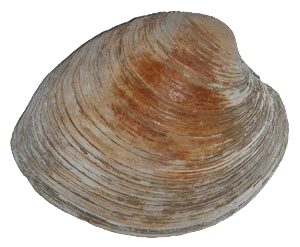| Shellfish - Hard Shell Clam |  |
Shellfish - Hard Shell Clam | | Mercenaria mercenaria | (A.K.A. Northern quahog, Hard clam, Littleneck, Cherrystone, Chowder)
| Key Distinguishing Markings:
- Shell heavy, thick and strong.
- Outside color grayish, sometimes tinged with brown or tan.
- Shell sculpture of numerous concentric growth lines with smooth area near middle of shell.
- Interior white, usually with a splotch of purple stain.
- Interior margin of shell with crenulations (fine teeth).
| Distribution:
- Hard-shell clams are found along the coast from the Gulf of St. Lawrence to Texas.
- In Maryland, they occur in higher salinity waters (>15 ppt), especially in the Atlantic coastal bays, with smaller populations in southern Tangier and Pocomoke Sounds and lower Chesapeake Bay.
| Size:
- Adults can grow as large as 125 mm (5 in)
- Sexual maturity is reached at a shell length of 32-38 mm (1 3/8-1 1/2 in)
- Various size groups have distinct common names:
- Button: <1 7/8 in
- Littleneck: 1 7/8 – 2 1/8 in
- Topneck: 2 1/8 – 2 3/8 in
- Cherrystone: 2 3/8 – 3 1/8 in
- >Chowder: >3 1/8 in
| Habitat:
- Hard-shell clams occur mainly in bays and estuaries along the coast, from the intertidal zone to depths of about 18 m (60 ft).
- They are found in a variety of substrates, but prefer sandy bottoms, especially with shell.
- The shell protects the more vulnerable smaller clams from predators.
- The clams live buried only about 1 – 2 in below the bay bottom.
| Spawning:
Spawning and Development:
- Hard-shell clams are capable of spawning from May-October, when water temperatures rise above about 23°C (73°F).
- The gametes are released into the water column, where fertilization occurs.
- Females can release as many as 16-24 million eggs per spawn, but this is highly variable; the average is about 7 million eggs per spawn.
- After fertilization, shelled larvae (sing. larva) develop. They swim in the water column for about 2 to 3 weeks, feeding on planktonic algae.
- Water currents distribute the larvae around the estuary.
- Mortality is very high during this stage of their life history.
- As the larvae get older, they begin to resemble little clams. Eventually, they develop a foot which they use to test the substrate for a suitable place to settle.
- After they find a good location, and if they large enough (~ 0.2 mm), the larvae undergo metamorphosis, when they change into the juvenile stage by attaching to the substrate with thin byssal threads (like a spider spinning a web, only simpler), losing their swimming organs, and developing gills and siphons.
- Eventually, at a size of about 7-9 mm, the juvenile clam loses its byssal threads and digs into the bottom.
- Although clams have a foot for digging, they remain in the same general location for the rest of their lives.
- Hard-shell clams in Maryland reach the legal harvesting size in about 3 years.
| Fishing Tips:
Clamming Tips:
- Clamming is a popular recreational activity in the coastal bays behind Ocean City and Assateague Island.
- Clams can be caught by raking or treading (feeling for the clams with your foot), especially in sandier areas.
- No license is required for recreational clamming but there are restrictions on the daily take and the minimum size that can be kept.
- For current regulations (both commercial & recreational), see Maryland's updated regulation page.
| Fun Fact:
- Hard-shell clams can live over 40 years.
- This species is enjoyed in a variety of culinary ways, such as chowders, clam bakes, and on the half shell. Clam chowder may have been the first American soup.
- People aren't the only species that eats hard-shell clams. A wide variety of predators, including snails, crabs, shrimp, starfish, fish, and birds consume clams.
- Herring gulls will carry clams into the air, and then drop them on hard surfaces such as rocks and parking lots to break their shells, allowing access to the meat.
- Aside from food, Native Americans prized the shells of hard-shell clams for making wampum beads. Wampum was used as a form of money, hence the Latin name Mercenaria for this species.
- The shells were also used for making tools such as scrapers, knives, spoons, and hoes.
- The hard-shell clam population in the coastal bays has only existed since the mid-1930's. A hurricane in 1933 created the Ocean City Inlet, which allowed the ocean to flood into the then-brackish bays, raising salinities and providing a suitable environment for the clams.
| | Family: Veneridae | | Order: Veneroida | | Class: Bivalvia | Phylum: Mollusca
For more information on hard-shell clams, please contact Mitchell Tarnowski.
Photograph courtesy of Mitchell Tarnowski
|
|
